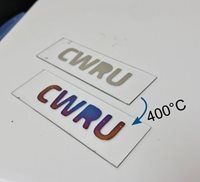Feb 21 2019
Scientists have learned that the early method of heating metal to produce vibrant colors forms a nanostructured surface that acts as a perfect light absorber. Perfect light absorbers—materials capable of absorbing over 99% of a specific color—can be utilized in solar panels, anti-counterfeiting, sensing, and stealth technologies.
 A thermally painted subwavelength metasurface produces a dazzling array of colors that do not change with viewing angle. An oxide layer that is a few nanometers thick was grown at the edge of the metal at high temperatures. This created the optical metasurface that perfectly absorbs certain wavelengths of light. (Image credit: Giuseppe Strangi, Case Western Reserve University)
A thermally painted subwavelength metasurface produces a dazzling array of colors that do not change with viewing angle. An oxide layer that is a few nanometers thick was grown at the edge of the metal at high temperatures. This created the optical metasurface that perfectly absorbs certain wavelengths of light. (Image credit: Giuseppe Strangi, Case Western Reserve University)
In the journal Optical Materials Express, researchers from Case Western Reserve University in Ohio report their findings of how colors are produced on heated metal surfaces and used that insight to develop a nickel thin-film that flawlessly absorbs red light.
We found that a 3,000-year-old metallurgy technique is actually one of the simplest examples of a metasurface—artificial surfaces with subwavelength features that impart unique electromagnetic properties. Creating color changes by depositing a single metal layer opens up new aesthetic possibilities in metalworking, as well as applications such as shielding devices from electromagnetic signals that cause noise and interference.
Giuseppe Strangi, Study Member, Case Western Reserve University.
In contrast to the iridescent colors of butterfly wings and water bubbles, which change based on the viewing angle, the thin oxide films formed by heating metal retain their colors at all angles. This could make the heat-induced color advantageous for creating holograms to safeguard currency and metal goods from counterfeiting.
A simple approach
In the past, researchers have exhibited perfect light absorption using ultrathin absorptive materials on metals or with well-engineered nanostructures. However, these materials need at least two material depositions using nanolithography fabrication techniques that are time-consuming, expensive, and hard to replicate.
“We showed that perfect light absorption could be realized using a simple thin-film with the right combination of oxide and metallic substrate,” said Strangi. “This combination naturally occurs with certain metals like the nickel and titanium we used in this study.”
To exhibit their method, the scientists placed 150 nm of titanium or nickel on silicon and then heated the films at 400 °C for 20 to 40 minutes to form an oxide layer. Study of the samples’ absorption properties revealed that the nickel films baked for 40 minutes absorbed about 99.94% of red light. The scientists also showed that the light absorption could be modified across near-infrared and visible wavelengths by adjusting the heating duration, which changes the oxide layer’s thickness.
How it works
Perfect light absorption takes place in the heated metal because light rays evolving from the oxide layer and the metal substrate combine in such a way that they cancel each other out—an occurrence referred to as total destructive interference. Any residual light is absorbed inside the metal substrate.
This method of creating perfect absorption is very practical due to its simplicity and reproducibility. The oxide layer makes the surface scratch resistant and protects it from further oxidation.
Giuseppe Strangi, Study Member, Case Western Reserve University.
The scientists plan to carry out further experiments to establish if high-resolution patterns can be developed by growing metal oxide layers. They are also aiming to design gas sensors with the perfect light absorbers.